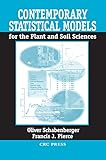Contemporary statistical models for the plant and soil sciences Libro electrónico Oliver Schabenberger, Francis J. Pierce
Tipo de material: Libro
en línea Idioma: Inglés Detalles de publicación: Boca Raton, Florida, United States CRC Press c2002Descripción: xxii, 738 páginas ilustraciones, mapa 26 centímetrosISBN:
Libro
en línea Idioma: Inglés Detalles de publicación: Boca Raton, Florida, United States CRC Press c2002Descripción: xxii, 738 páginas ilustraciones, mapa 26 centímetrosISBN: - 1584881119
- 9781584881119
- 9781420040197
- Disponible en línea
Incluye bibliografía e índice
Statistical models.. Mathematical and statistical models.. Functional aspects of models.. The inferential steps ó estimation and testing.. T-Tests in terms of statistical models.. Embedding hypotheses.. Hypothesis and significance testing ó interpretation of the p-value.. Classes of statistical models.. Data structures.. Introduction.. Classification by response type.. Classification by study type.. Clustered data.. Autocorrelated data.. From independent to spatial data ó a progression of clustering.. Linear algebra tools.. Introduction.. Matrices and vectors.. Basic matrix operations.. Matrix inversion ó regular and generalized inverse.. Mean, variance, and covariance of random vectors.. The trace and expectation of quadratic forms.. The multivariate Gaussian distribution.. Matrix and vector differentiation.. Using matrix algebra to specify models.. The classical linear model: least squares and alternatives.. Introduction.. Least squares estimation and partitioning of variation.. Factorial classification.. Diagnosing regression models.. Diagnosing classification models.. Robust estimation.. Nonparametric regression .. Nonlinear models.. Introduction.. Models as laws or tools.. Linear polynomials approximate nonlinear models.. Fitting a nonlinear model to data.. Hypothesis tests and confidence intervals.. Transformations.. Parameterization of nonlinear models.. Applications.. Generalized linear models.. Introduction.. Components of a generalized linear model.. Grouped and ungrouped data.. Parameter estimation and inference.. Modeling an ordinal response.. Overdispersion.. Applications.. Linear mixed models for clustered data.. Introduction.. The Laird-Ware model.. Choosing the inference space.. Estimation and inference.. Correlations in mixed models.. Applications.. Nonlinear models for clustered data.. Introduction.. Nonlinear and generalized linear mixed models..
Towards an approximate objective function.. Applications.. Statistical models for spatial data.. Changing the mindset.. Semivariogram analysis and estimation.. The spatial model.. Spatial prediction and the kriging paradigm.. Spatial regression and classification models.. Autoregressive models for lattice data.. Analyzing mapped spatial point patterns.. Applications.. Bibliography
Disponible para usuarios de ECOSUR con su clave de acceso
Despite its many origins in agronomic problems, statistics today is often unrecognizable in this context. Numerous recent methodological approaches and advances originated in other subject-matter areas and agronomists frequently find it difficult to see their immediate relation to questions that their disciplines raise. On the other hand, statisticians often fail to recognize the riches of challenging data analytical problems contemporary plant and soil science provides. The first book to integrate modern statistics with crop, plant and soil science, Contemporary Statistical Models for the Plant and Soil Sciences bridges this gap. The breadth and depth of topics covered is unusual. Each of the main chapters could be a textbook in its own right on a particular class of data structures or models. The cogent presentation in one text allows research workers to apply modern statistical methods that otherwise are scattered across several specialized texts. The combination of theory and application orientation conveys ìwhyî a particular method works and ìhowî it is put in to practice. About the CD-ROM The accompanying CD-ROM is a key component of the book. For each of the main chapters additional sections of text are available that cover mathematical derivations, special topics, and supplementary applications. It supplies the data sets and SAS code for all applications and examples in the text, macros that the author developed, and SAS tutorials ranging from basic data manipulation to advanced programming techniques and publication quality graphics. Contemporary statistical models can not be appreciated to their full potential without a good understanding of theory. They also can not be applied to their full potential without the aid of statistical software. Inglés
Contemporary Statistical Models for the Plant and Soil Science provides the essential mix of theory and applications of statistical methods pertinent to research in life sciences. *In-depth discussion of how to choose and use the appropriate statistical technique for solving a given problem. *Extensive figures enable you to visualize important concepts. *Speedy access to precise data and computer code through electronic media. *SAS code and output discussed in the text for your benefit. *More than 35 case studies, many reflecting authors' consulting projects, facilitate your understanding of statistical theory. Inglés
Disponible en línea
Adobe Acrobat profesional 6.0 o superior


